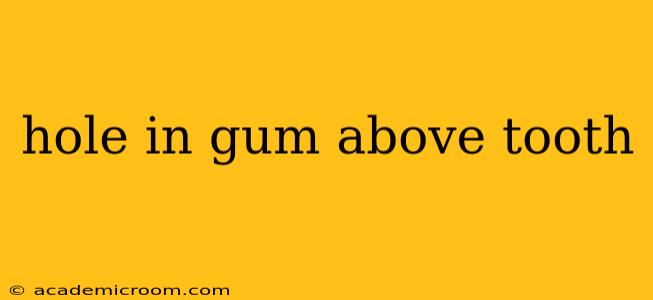A hole in the gum above a tooth, medically known as a periodontal pocket or gum recession, is a common dental problem that can lead to serious oral health issues if left untreated. Understanding the causes, treatments, and preventative measures is crucial for maintaining good oral hygiene and preventing further complications. This comprehensive guide will address common concerns and provide valuable insights into this dental concern.
What Causes a Hole in the Gum Above a Tooth?
Several factors contribute to the formation of holes or pockets in the gums above teeth. These can range from poor oral hygiene to more serious underlying conditions. The most common causes include:
-
Gum Disease (Periodontal Disease): This is the most prevalent cause. Bacteria build up along the gum line, causing inflammation (gingivitis) and eventually leading to the destruction of the supporting tissues, creating pockets between the teeth and gums. Advanced gum disease (periodontitis) can result in significant bone loss and tooth loss.
-
Aggressive Brushing: While brushing is essential, overly aggressive brushing techniques can wear away the gum tissue over time, creating recession and exposing the tooth roots.
-
Genetics: Some individuals are genetically predisposed to gum recession and periodontal disease. Family history of gum problems significantly increases the risk.
-
Misaligned Teeth (Malocclusion): Teeth that are crowded or improperly aligned can make it difficult to clean effectively, increasing the risk of gum disease and recession.
-
Trauma: Injury to the gums, such as from a fall or accident, can cause tissue damage and lead to gum recession.
-
Piercings: Oral piercings, especially those placed near the gum line, can contribute to gum irritation and recession.
-
Grinding or Clenching Teeth (Bruxism): This habit can put excessive pressure on the teeth and gums, leading to recession over time.
-
Smoking: Smoking significantly increases the risk of periodontal disease and gum recession, impairing the body's ability to heal.
-
Certain Medical Conditions: Some medical conditions, such as diabetes, can impair the body's immune response and increase susceptibility to gum disease.
What Does a Hole in the Gum Above a Tooth Feel Like?
The symptoms associated with a hole in the gum above a tooth vary depending on the severity of the issue. However, common symptoms include:
- Sensitivity: Exposed tooth roots are often sensitive to hot, cold, sweet, or acidic foods and drinks.
- Bleeding Gums: Gums may bleed easily when brushing or flossing.
- Redness and Swelling: The gums may appear red, swollen, and inflamed.
- Pus: In advanced cases, pus may be present in the gum pockets.
- Loose Teeth: In severe cases, the supporting bone structure may be damaged, leading to loose teeth.
- Bad Breath (Halitosis): Persistent bad breath can be a sign of underlying gum disease.
How is a Hole in the Gum Above a Tooth Treated?
Treatment for a hole in the gum above a tooth depends on the underlying cause and severity of the condition. Treatment options may include:
-
Scaling and Root Planing: This deep cleaning procedure removes plaque and tartar from below the gum line, smoothing the tooth roots to promote healing.
-
Antibiotics: In cases of infection, antibiotics may be prescribed to combat bacteria.
-
Gum Grafting: This surgical procedure involves taking tissue from another area of the mouth (or sometimes from a donor) and grafting it onto the affected area to cover the exposed root.
-
Guided Tissue Regeneration (GTR): This technique uses special membranes to help guide the regeneration of gum tissue and bone.
-
Bone Grafting: In cases of significant bone loss, bone grafting may be necessary to support the teeth.
Can a Hole in the Gum Above a Tooth Heal on Its Own?
Generally, a hole in the gum above a tooth will not heal on its own. Without professional treatment, the condition is likely to worsen, leading to further gum recession, bone loss, and ultimately, tooth loss. Early intervention is crucial to prevent further damage.
How Can I Prevent Holes in My Gums?
Practicing good oral hygiene is the most effective way to prevent holes in your gums. This includes:
- Brushing: Brush your teeth twice a day with a soft-bristled toothbrush using gentle, circular motions.
- Flossing: Floss daily to remove plaque and food particles from between your teeth.
- Mouthwash: Use an antimicrobial mouthwash to help kill bacteria.
- Regular Dental Checkups: Visit your dentist for regular checkups and cleanings. Early detection and treatment of gum disease are essential for preventing severe complications.
- Healthy Diet: Maintain a balanced diet low in sugar and processed foods.
- Quit Smoking: If you smoke, quitting is crucial for improving your gum health.
Is a Hole in Gum Above Tooth Serious?
Yes, a hole in the gum above a tooth, especially if caused by periodontal disease, can be quite serious if left untreated. It can lead to tooth loss, bone loss, and other oral health complications. Therefore, seeking professional dental care is essential.
By understanding the causes, symptoms, treatment options, and prevention strategies outlined above, you can take proactive steps to maintain healthy gums and prevent the development of holes in your gums above your teeth. Remember, regular dental checkups are vital for early detection and treatment of any oral health issues.
